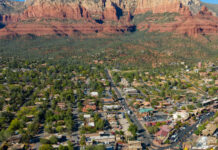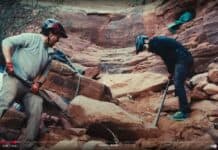
Village of Oak Creek author J. Eric Smith has released his nonfiction book “Side by Side in Eternity: The Lives Behind Adjacent American Military Graves,” written with his fellow U.S. Naval Academy graduate, Rear Adm. James R. McNeal.
“Every gravestone in every graveyard can frame a story far more complex than the dates engraved upon it,” the authors said in a press release. “It’s common for spouses to be memorialized together as a final affirmation of the commitments made in life, or for bereaved parents to be buried with children who tragically preceded them in death. Close burials of seemingly unrelated figures can similarly reveal the tales of people who otherwise walked together in life, by choice or by chance. ‘Side by Side in Eternity’ explores a dozen examples of such side-by-side burials over the course of U.S. history.”
The idea for the book came from the authors’ reflections on the lives of people whom they had noticed buried next to one another.
For McNeal, that experience involved coming across U.S. Sen. John McCain’s grave at the U.S. Naval Academy Cemetery in Annapolis, Md., and learning that McCain was buried next to his Naval Academy classmate Adm. Chuck Larson.
“My father is buried at Beaufort National Cemetery in Beaufort, South Carolina. He was a career Marine Corps officer,” Smith said. “The grave next to his is [that of] a soldier who died in 1865 [while serving] in what was then called the U.S. Colored Troops, which were the African-American soldiers that fought for the Union in the South. His grave only has one name on it, ‘Harris.’ I am intrigued by this concept that my dad is lying next to this person who died for his country, but they don’t even know his name.”
The book documents cases of both those whose lives took different directions, but who nevertheless always knew they wanted to be buried together, and those whose graves ended up next to one another by happenstance. It also discusses the history of funeral practices and military rituals.
“One of the more interesting ones was Fort Leavenworth, Kansas, in a little cemetery in the woods,” Smith said. “There are 14 graves on the back line of the cemetery with all German names on them. Those 14 were the last mass executions performed by the federal government after World War II. They were German POWs interned at the US Disciplinary Barracks, and they were hung in an elevator shaft and buried there. That’s a ‘side-by-side’ that none of them made any plans [for when] growing up in various parts of Germany, ending up where they were.”
The POWs were executed for the murder of a fellow German POW suspected of giving secrets to the Americans.
Smith and McNeal are working on their next book, to be titled “Crucibles: History’s Most Formidable Rites of Passage.” It is scheduled for an early 2025 release. They are basing it on their own experiences of “plebe summer” and “plebe year” at the Naval Academy, the first six weeks and year, respectively, of intensive hazing that begin a cadet’s introduction to military life.
“[The goal is], we find 20 other organizations throughout history and we look at their rites of passage and do an analytical approach,” Smith said. “We’ll tell the stories like we do in ‘Side by Side,’ but then have a synthesis about what, if anything, modern businesses and organizations can learn through the history of rites of passage, about how they work or how they didn’t work.”
“Beyond the history aspects of [the book], it’s an invitation for people to explore their own side-by-side stories,” Smith added. “The next time you go to a cemetery to see a loved one, pay attention, because there are interesting history stories to be told by making those connections between people.”

















